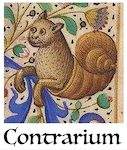Walpurgisnacht
Or just Vappu in Finland
German might not sound as musical or romantic as French or Italian, but it is a great language for solemn, intriguing, seemingly fateful words. Take Walpurgisnacht, for instance. It may sound like a curse or an omen, but it just means Night of (Saint) Walpurga (or more exactly, if less literally, The Eve of Saint Walpurga’s feast).
However, the current holiday, called more simply Vappu in Finland, is actually a mix of three different celebrations, one Christian, one Pagan and one political, all converging on May 1st and the night before.
Saint Walpurga or Walburga (710 – 777) was an Anglo-Saxon woman from a prominent family who became a Christian missionary in Germany (Bavaria), and lived as an abbess in a monastery in the Bavarian village of Heidenheim. She was canonized and her remains were transferred to the town of Eichstätt on May 1st, 870. Since then, May 1st became her traditional celebration, and the night before, Walpurgisnacht.
During Medieval times, people prayed to Saint Walpurga to protect themselves against the effects of witchcraft. A tradition holds that during Walpurgisnacht, the night before her feast, witches hold their Sabbaths and the evil powers are at their highest. According to German historian Johannes Praetorius (1630-1680), it was believed that on that night witches rode to the top of the Brocken, Germany’s highest mountain, where they danced and fornicated with the Devil.
Meanwhile at night in Walpurgis Eve
In large numbers as I report
The Witches with her offspring
Generally hold a meeting
The young as well as the old
Which all the devil leads there
On which they dance and jump
Spending time drinking too
Fornicating with evil spirits
Goethe probably used this as a reference for a scene in his Faust play, called Walpurgisnacht, where witches ride to the top of the Brocken with “stinking old goats” (devils).
As you can see, the association of Walpurgisnacht with witches and devils is probably quite old. In medieval Germany, during that night, people would hold bonfires on hills, as a form of protection from evil. The tradition still remains in some parts of the country even today.
It was common in the early development of Christianity for a few Pagan feasts or symbols to be incorporated into Christian traditions, but this is a slightly more complicated case. While the date of the canonization and transfer or the remains of the Saint might have been a coincidence and not chosen for any specific reason, many associate May Day/Walpurgisnacht with the Scandinavian and Germanic early pagan celebrations of Spring, which took place around the same period in late April or early May, and included lighting bonfires, among other things. So it is possible that both celebrations became, with time, mixed together. Or, perhaps more accurately, the new religious feast allowed for a continuation of traditional folk eastern rites. According to the Encyclopedia Britannica, “Although it is likely that the date of her canonization is purely coincidental to the date of the pagan celebrations of spring, people were able to celebrate both events under church law without fear of reprisal.”
Some even say that the word Walpurgis (Valborg in Swedish and Norwegian) has another meaning unrelated to the name of the Saint. In the Old Norse language, Val means dead or slain (think Valhalla, which means Hall of the Slain, or Valkyrie: “chooser of the slain”). “Borg” means mountain or mount. So Valborg could mean something like “mountain of the slain”. But it seems a convoluted explanation, and the relation with the feast is unclear, except perhaps for its association with mountains (and witches gathering on top of mountains).
There are other etymological theories for Walpurgis/Valborg/Vappu, but none of them are completely convincing. Since Valborg (Walburg in German) is still a common female name in Scandinavian countries, it is more likely that the feast’s name comes from the Saint’s name indeed. “Walburg” comes from High German waltan (to rule) with burg (fortress). Perhaps a possible translation could be “mighty fortress”.
May 1st may still have some religious tones in Bavaria, where there are still processions to Saint Walburga’s tomb in Eichstatt. But, in Finland, the celebration became mixed with the Labour Day holiday on May 1st, which was important for political reasons, and has become almost completely secularized. Few people even seem to remember its origins, either Pagan or Christian — it’s more an excuse for students to party, if anything, as it coincides with the beginning of their Spring break. I quote the Encyclopedia Britannica again:
“Initially, Walpurgis Night was celebrated by the Finnish upper class. Then, in the late 19th century, students (most notably engineering students) took up its celebration. Today merrymaking begins on the evening of April 30, often augmented with the drinking of alcoholic beverages, particularly sparkling wine. The carnival-like festivities carry over to the next day, frequently taking on a family dimension, as friends and relatives picnic in parks among balloons and consume sima, a homemade low-alcohol mead.”
Sima is a fermented beverage traditionally made with lemon, honey and yeast, but today it is sold ready-made in supermarkets as a soft drink. Its alcoholic content is less than 1%. I tried it. It tastes more or less like a lemonade.
So — Vappu in Finland is neither witches’ day nor pagan ceremony nor religious festival, but just a night for partying and a day for picnic. Another tradition, exclusive to Finland and connected to its appropriation by university students, is to put graduation caps on statues. In Helsinki, it means the statue of Havis Amanda.
So, basically, even if it is considered the fourth most important holiday in Finland, it seems to be, today, mostly just an excuse to party. So much so that, in an introductory book that I’ve read about Finland, they talk about the holiday but do not explain its name or origins. They just mention, very vaguely, Labour Day.

